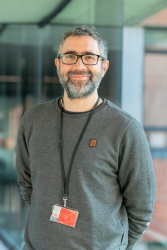IFIC researcher Carlos Mariñas appointed Deputy Spokesperson of the Belle II experiment in Japan
The scientist from the Institute of Corpuscular Physics (CSIC-UV) co-leads an international collaboration of over 1,000 people from 28 countries.
Carlos Mariñas Pardo, a tenured scientist at the Spanish National Research Council (CSIC) at the Institute of Corpuscular Physics (IFIC), a joint center of the CSIC and the University of Valencia, has been elected Deputy Spokesperson of the Belle II experiment. This large detector of subatomic particles is located at the SuperKEKB accelerator in Japan, which holds the world record for the highest number of collisions inside a particle accelerator in pursuit of new phenomena in physics. The Spanish scientist will play a central role in the scientific and technical coordination of the collaboration operating the experiment, particularly in enhancing the detector. His term will last until June 2027.
At the general meeting held from June 16 to 20 in Japan, the Institutional Committee ratified the appointment of Carlos Mariñas, who joins Florian Bernlocher (University of Bonn, Germany) and Kodai Matsuoka (KEK, Japan) on the executive team coordinating the Belle II Collaboration. The collaboration includes more than 1,000 researchers from 138 institutions across 28 countries. Belle II is located at the SuperKEKB accelerator, the most intense of its kind in the world. In particle physics, this intensity is measured by luminosity—the number of collisions between particles per unit of time. SuperKEKB doubles the previous record held by its predecessor, KEKB.
The goal of the Belle II experiment is to discover new physics beyond the Standard Model of particle physics, the theory that describes the matter in our universe. For instance, it searches for hypothetical dark matter particles, which make up 25% of the universe but have yet to be detected, or leptoquarks, which could explain anomalies recently observed in B-meson decays.
The Belle II detector is designed for precise characterization of B mesons, a type of heavy particle composed of beauty (or b) quarks—one of the building blocks of visible matter. Identifying rare or forbidden decays of this particle according to the Standard Model would indicate the presence of new physics. The research program also includes the study of exotic states and the precise measurement of processes crucial for understanding the anomalous magnetic moment of the muon—another unsolved puzzle in physics.
Searching for new particles
With a research career focused on the development of large-area DMAPS demonstrators for pixel detectors and their application in future particle physics experiments, Carlos Mariñas has already served as Deputy Operations Coordinator of Belle II since its start-up in 2019. As Technical Coordinator of the experiment, he also led the installation of a new pixel detector and the upgrade of several sub-detectors during its shutdown between 2022 and 2023.
As Deputy Spokesperson, the CSIC scientist assumes a central role in the scientific and technical coordination of the collaboration, particularly in the operation and improvement of the detector for its high-luminosity phase, expected in 2032. “We are entering a particularly exciting phase for the Belle II experiment, where we plan to operate with high efficiency at peak luminosities never seen before,” says Mariñas. “With this large data set and the excellent performance of the detector, Belle II is entering a stage of searching for new processes and particles that could transform our understanding of the fundamental components of matter,” he adds.
The Belle II experiment and the semiconductor technologies developed there also play a central role in the IFIC’s Severo Ochoa Excellence Project. Moreover, the SuperKEKB accelerator is contributing to the development of key technologies for the future Higgs factory at CERN—a facility designed to produce Higgs bosons in large quantities, the particle responsible for mass in the universe, discovered at CERN’s ATLAS and CMS experiments in 2012.




















